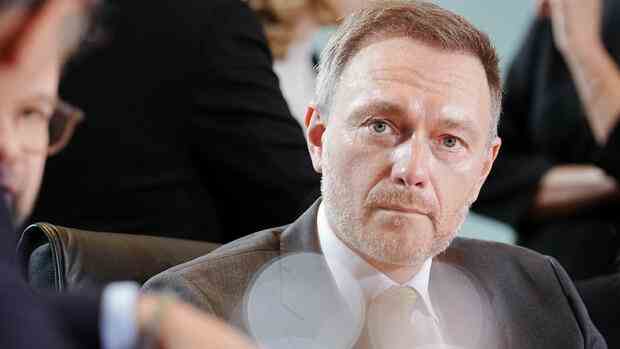The Federal Minister of Finance is asking his fellow ministers to save because of the budget gaps.
(Photo: dpa)
Berlin In the budget planning of Federal Finance Minister Christian Lindner (FDP), there are gaps in the billions, both in the short and medium term. This emerges from an internal presentation by the Federal Ministry of Finance for a meeting of state secretaries from all ministries last Friday. The paper is available to the Handelsblatt.
The meeting of state secretaries was the prelude to budget deliberations for the coming year. Lindner’s Secretary of State for the Budget, Werner Gatzer, used it primarily to call for savings. According to the presentation, the federal government still has to close a financing gap of twelve billion euros for 2024 if the debt brake is to be adhered to as planned.
The reason for this is “additional burdens not shown” in the budget of 31 billion euros, including higher interest payments, tax relief through the Inflation Compensation Act and greater support for the federal states in the area of local public transport.
The 31 billion euros in additional expenditure would be offset by additional tax revenue of 16 billion euros. In addition, there is a higher debt margin of three billion euros due to the weakening economy.
Top jobs of the day
Find the best jobs now and
be notified by email.
>> Read here: Germany incurs fewer new debts than planned
The bottom line is that there is a gap of twelve billion euros, which the presentation describes as “need for action”. In order to close them, the ministries should save. The current financial plan is the “absolute upper limit” for the spending requests of the individual departments, was Gatzer’s message to his fellow state secretaries on Friday. The additional burdens would have to be financed within these existing approaches.
“Cuts cannot be ruled out”
“Each department is called upon to identify potential reallocations of its expenditure at an early stage,” the presentation says. And then the Ministry of Finance threatens to cut costs: “If this is not enough or there are other additional budgetary burdens, cuts in the respective departmental plans cannot be ruled out.”
>> Read here: Up to 2200 euros more: This is how singles and families benefit from the relief in 2023
According to the Ministry of Finance, the situation is already tense this year. As a result of the crisis management, an increase in the debt ratio to around 70 percent of gross domestic product (GDP) is to be expected in 2023. According to current projections, the deficit ratio will continue to be significantly higher at 4.5 percent of GDP.
The State Secretary in the Federal Ministry of Finance warns against excessive spending.
(Photo: dpa)
The EU rules actually envisage a debt level of less than 60 percent and a maximum borrowing of three percent of GDP. However, the requirements had been suspended due to the corona pandemic and the economic consequences of the Ukraine war. For a long time there has been a discussion at European level as to whether the rules need to be changed.
Up to 30 billion euros are missing from the climate fund
The federal government had also suspended the debt brake in the past three years. From this year onwards it should take effect again. In order to facilitate the transition from crisis mode to normal budget planning, the traffic light coalition had taken precautions and filled the so-called climate and transformation fund (KTF) with billions. This should make it possible to finance investments in climate protection, even if the debt brake in the federal budget restricts the scope.
But even in the KTF there is a gap in the billions, as can be seen from the presentation by the Ministry of Finance. In the period from 2024 to 2027, 25 to 30 billion euros were missing. The reason for this is “changed framework conditions”, which means that the “income is massively lower”, according to the paper.
The federal government is suspending the increase in the CO2 price because of the energy crisis – the proceeds from this flow into the KTF and are now lower. The income from EU emissions trading is also not as high as originally thought.
The climate fund currently has around 90 billion euros at its disposal. In total, expenditures of over 200 billion euros are planned for the years 2022 to 2026. The fund is intended to support the transformation of the economy towards climate neutrality. Among other things, various funding programs are financed from it.
More: More money for investments: Economy demands reform of the debt brake
